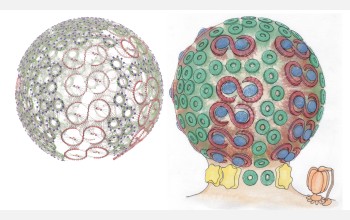News Release 06-137
National Science Foundation Awards Texas Advanced Computing Center $59 Million for High-Performance Computing
University and industry consortium to deploy powerful general-purpose computing system

Scientists will use the TACC computer to simulate the 10 million atoms in this bacterial organelle.
September 29, 2006
This material is available primarily for archival purposes. Telephone numbers or other contact information may be out of date; please see current contact information at media contacts.
The National Science Foundation (NSF) has made a five-year, $59 million award to the Texas Advanced Computing Center (TACC) at The University of Texas (UT) at Austin and its partners at Arizona State University and Cornell University to acquire, operate and support a high-performance computing system that will provide unprecedented computational power to the nation's scientists and engineers.
TACC is partnering with Sun Microsystems to deploy a supercomputer system specifically developed to support very large science and engineering computing requirements. In its final configuration in 2007, the supercomputer will have a peak performance in excess of 420 trillion floating point operations per second (teraflops), making it one of the most powerful supercomputer systems in the world. It will also provide over 100 trillion bytes (terabytes) of memory and 1.7 quadrillion bytes (petabytes) of disk storage. The system is based on Sun Fire(TM) x64 (x86, 64-bit) servers and Sun StorageTek(TM) disk and tape storage technologies, and will use AMD's forthcoming quad-core processors.
The University of Texas at Austin project team is led by TACC director Jay Boisseau and includes researchers from TACC and UT's Institute for Computational Engineering & Sciences.
High-performance computing (HPC) has become a vital investigative tool in many science and engineering disciplines. It enables testing and validation of theories and analysis of vast volumes of experimental data generated by modern scientific instruments, such as the very high-energy particle accelerators in the United States and Europe. HPC makes it possible for researchers to conduct experiments that would otherwise be impossible--studying the dynamics of the Earth's climate in the distant past, for example, investigating how the universe developed, or discovering how complex biological molecules mediate life processes. In industry, high-performance computing is used in everything from aircraft design and improvement of automobile crash-worthiness, to the creation of breath-taking animations in the cinema and production of snack food.
Increasingly, high-performance computing is becoming an engine for American competitiveness as President Bush emphasized in his 2006 State of the Union address, and as noted in reports from both the National Academy of Sciences and the Council on Competitiveness. High-performance computing is one of the components of the American Competitiveness Initiative.
HPC systems are enabling researchers to address important problems in nearly all fields of science. From understanding the 3-D structure and function of proteins to predicting severe weather events, HPC resources have become indispensable to knowledge discovery in life sciences, geosciences, social sciences and engineering, producing results that have direct bearing on society and quality of life. HPC resources are required for basic research across disciplines, from understanding the synthesis of all heavy elements via supernova explosions to mapping the evolutionary history of all organisms throughout the history of life on Earth.
"This Sun system will enable scientific codes to achieve greater performance on vastly larger problems, with higher resolution and accuracy, than ever before. It will be one of the most important scientific instruments in the world," said TACC's Boisseau.
-NSF-
Media Contacts
Marcia Inger, TACC, (512) 471-4904, email: minger@tacc.utexas.edu
Leslie Fink, NSF, (703) 292-5395, email: lfink@nsf.gov
Related Websites
Texas Advanced Computing Center: http://www.tacc.utexas.edu
NSf Office of Cyberinfrastructure: http://www.nsf.gov/dir/index.jsp?org=OCI
NSF Special Report on Computing: http://www.nsf.gov/news/overviews/computer/index.jsp
NSF Special Report on Cyberinfrastructure: http://www.nsf.gov/news/special_reports/cyber/index.jsp
The U.S. National Science Foundation propels the nation forward by advancing fundamental research in all fields of science and engineering. NSF supports research and people by providing facilities, instruments and funding to support their ingenuity and sustain the U.S. as a global leader in research and innovation. With a fiscal year 2023 budget of $9.5 billion, NSF funds reach all 50 states through grants to nearly 2,000 colleges, universities and institutions. Each year, NSF receives more than 40,000 competitive proposals and makes about 11,000 new awards. Those awards include support for cooperative research with industry, Arctic and Antarctic research and operations, and U.S. participation in international scientific efforts.
Connect with us online
NSF website: nsf.gov
NSF News: nsf.gov/news
For News Media: nsf.gov/news/newsroom
Statistics: nsf.gov/statistics/
Awards database: nsf.gov/awardsearch/
Follow us on social
Twitter: twitter.com/NSF
Facebook: facebook.com/US.NSF
Instagram: instagram.com/nsfgov


